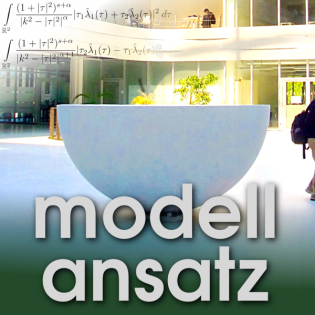
Podcast
Podcaster
Beschreibung
vor 10 Jahren
Prof. Francisco Sayas from the Department of Mathematical
Sciences of the University of Delaware in Newark has been
visiting our faculty in June 2015. He is an expert in the
simulation of scattering of transient acoustic waves.
Scattering is a phenomenon in the propagation of waves. An
interesting example from our everyday experience is when sound
waves hit obstacles the wave field gets distorted. So, in a way,
we can "hear" the obstacle.
Sound waves are scalar, namely, changes in pressure. Other wave
types scatter as well but can have a more complex structure. For
example, seismic waves are elastic waves and travel at two
different speeds as primary and secondary waves.
As mathematician, one can abandon the application completely and
say a wave is defined as a solution of a Wave Equation. Hereby,
we also mean finding these solution in different appropriate
function spaces (which represent certain properties of the class
of solutions), but it is a very global look onto different wave
properties and gives a general idea about waves. The equations
are treated as an entity of their own right. Only later in the
process it makes sense to compare the results with experiments
and to decide if the equations fit or are too simplified.
Prof. Sayas startet out in a "save elliptic world" with
well-established and classical theories such as the mapping
property between data and solutions. But for the study of wave
equations, today there is no classical or standard method, but
very many different tools are used to find different types of
results, such as the preservation of energy. Sometimes it is
obvious, that the results cannot be optimal (or sharp) if e.g.
properties like convexity of obstacles do not play any role in
getting results. And many questions are still wide open. Also,
the numerical methods must be well designed.
Up to now, transient waves are the most challenging and
interesting problem for Prof. Sayas. They include all frequencies
and propagate in time. So it is difficult to find the correct
speed of propagation and also dispersion enters the
configuration. On the one hand, the existence and regularity
together with other properties of solutions have to be shown, but
on the other hand, it is necessary to calculate the propagation
process for simulations - i.e. the solutions - numerically.
There are many different numerical schemes for bounded domains.
Prof. Sayas prefers FEM and combines them with boundary integral
equations as representative for the outer domain effects. The big
advantage of the boundary integral representation is that it is
physical correct but unfortunately, it is very complicated and
all points on the boundary are interconnected.
Finite Elements fit well to a black box approach which leads to
its popularity among engineers. The regularity of the boundary
can be really low if one chooses Galerkin methods. The
combination of both tools is a bit tricky since the solver for
the Wave Equations needs data on the boundary which it has to get
from the Boundary element code and vice versa. Through this
coupling it is already clear that in the coding the integration
of the different tools is an important part and has to be done in
a way that all users of the code which will improve it in the
future can understand what is happening.
Prof. Sayas is fascinated by his research field. This is also due
to its educational aspect: the challenging mathematics, the set
of tools still mainly unclear together with the intensive
computational part of his work. The area is still wide open and
one has to explain mathematics to other people interested in the
results.
In his carreer he started out with studying Finite Elements at
the University in Zaragoza and worked on boundary elements with
his PhD-supervisor from France. After some time he was looking
for a challenging new topic and found his field in which he can
combine both fields. He has worked three years at the University
of Minnesota (2007-2010) and decided to find his future at a
University in the U.S.. In this way he arrived at the University
of Delaware and is very satisfied with the opportunities in his
field of research and the chances for young researchers.
Literature and additional material
deltaBEM - Easy to Implement Boundary Integral Equations,
open source software developed by Team Pancho at the Department
of Mathematical Sciences in Delaware.
A. R. Laliena, F. J. Sayas: Theoretical aspects of the
application of convolution quadrature to scattering of acoustic
waves, Numerische Mathematik, 112(4), 637-678, 2009.
F. J. Sayas: Energy estimates for Galerkin
semidiscretizations of time domain boundary integral equations,
Numerische Mathematik, 124(1), 121-149, 2013.
Modellansatz Podcast 003: Unsichtbarkeit (in German)
Weitere Episoden

37 Minuten
vor 4 Monaten

35 Minuten
vor 7 Monaten

16 Minuten
vor 1 Jahr

1 Stunde 42 Minuten
vor 2 Jahren

50 Minuten
vor 3 Jahren
In Podcasts werben
Abonnenten

Neutraubing

Darmstadt

Groß Gusborn

Hagen

Karlsruhe





Kommentare (0)